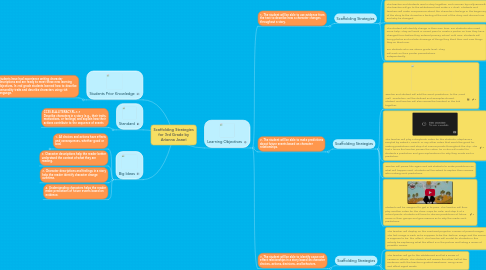
1. Standard
1.1. CCSS.ELA-LITERACY.RL.3.3 Describe characters in a story (e.g., their traits, motivations, or feelings) and explain how their actions contribute to the sequence of events
2. Learning Objectives
2.1. 1. The student will be able to use evidence from the text to describe how a character changes throughout a story.
2.1.1. Scaffolding Strategies
2.1.1.1. The teacher will make a model for students of his or her personal change from childhood to adulthood. Teacher will make a powerpoint presentation or poster board and include photographs and descriptions of how they have changed overtime including physical features, likes/dislikes, behaviors, etc.
2.1.1.2. The teacher and students read a story together, Not Norman by Kelly Bennett. The teacher will go to the whiteboard and make a T chart. Students and teachers will make comparisons about the character's feelings in the beginning of the story to the character's feeling at the end of the story and discuss how and why he changed.
2.1.1.3. The student will identify change in their own lives. For students who need more help: They will work in mixed pairs to create a poster on how they have changed from before they entered primary school until now. Students will bring photos and include drawings of things they liked then and new things they've liked now. For students who are above grade level: They will work on their poster presentations independently.
2.2. 2. The student will be able to make predictions about future events based on character relationships.
2.2.1. Scaffolding Strategies
2.2.1.1. Teacher and student will add the word 'prediction' to the Word Wall. 'Prediction' will be defined and examples shared. Student and teacher will also review the handout in the link together.
2.2.1.2. The teacher will play a storybook video for the students, Stephanie's Ponytail by Robert Munsch, or any other video that would be good for making predictions and stop it at various points throughout the clip. The first 2 times the teacher pauses the video, he or she will model for students a prediction and give explanations for why they made such a prediction.
2.2.1.3. Teacher will pause film again and ask students to make predictions on what will happen next. Students will be asked to explain their reasons wfor making such predictions.
2.2.1.4. Students will be assigned to get in to pairs. The teacher will then play another video for the class, Caps for Sale, and stop it at 3 critical points, Students will have to discuss predictions of future evens in their groups and give reasons as to why the made such predictions.
2.3. 3. The student will be able to identify cause and effect relationships in a story based on character choices, actions, decisions, and behaviors.
2.3.1. Scaffolding Strategies
2.3.1.1. The teacher will display on the overhead projector a series of paired images. The first image in each set is suppose to be the 'before' image and the second is suppose to be the 'effect.' The teacher will model for students in this activity be explaining what the effect is in the picture and listing a series of possible causes.
2.3.1.2. The teacher will go to the whiteboard and list a series of causes or effects. The students will answer the other half of the sentence, with the teacher's guided assistance, using cause and effect signal words.
2.3.1.3. Students will get in groups of 3 and will write on strips of paper 5 various effects and will throw them into a hat. The teacher will then go around the room and have each group pick 5 strips from the hat. The teams will then have to brainstorm in the groups lists of causes for each effect given.
3. Big Ideas
3.1. 1. All choices and actions have effects and consequences, whether good or bad.
3.1.1. Project specifications
3.1.2. End User requirements
3.1.3. Action points sign-off
